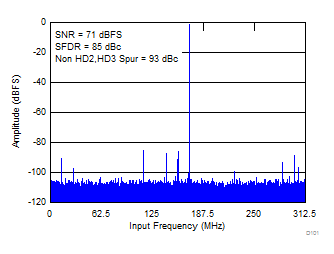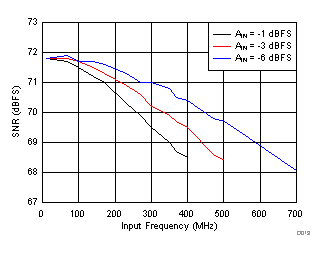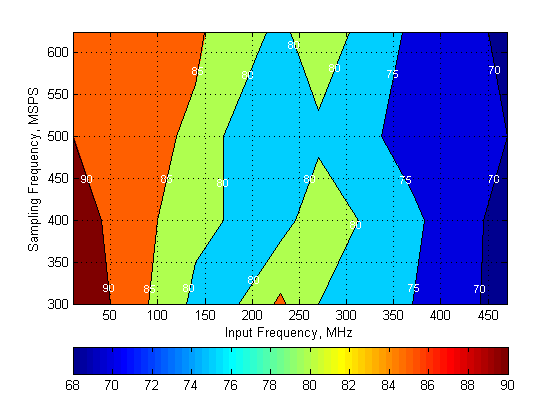-
ADS54J42 Dual-Channel, 14-Bit, 625-MSPS, Analog-to-Digital Converter
- 1 Features
- 2 Applications
- 3 Description
- 4 Revision History
- 5 Device Comparison Table
- 6 Pin Configuration and Functions
- 7 Specifications
-
8 Detailed Description
- 8.1 Overview
- 8.2 Functional Block Diagram
- 8.3 Feature Description
- 8.4 Device Functional Modes
- 8.5
Register Maps
- 8.5.1 Detailed Register Info
- 8.5.2 Example Register Writes
- 8.5.3
Register Descriptions
- 8.5.3.1 General Registers
- 8.5.3.2
Master Page (080h) Registers
- 8.5.3.2.1 Register 20h (address = 20h), Master Page (080h)
- 8.5.3.2.2 Register 21h (address = 21h), Master Page (080h)
- 8.5.3.2.3 Register 23h (address = 23h), Master Page (080h)
- 8.5.3.2.4 Register 24h (address = 24h), Master Page (080h)
- 8.5.3.2.5 Register 26h (address = 26h), Master Page (080h)
- 8.5.3.2.6 Register 39h (address = 39h), Master Page (080h)
- 8.5.3.2.7 Register 3Ah (address = 3Ah), Master Page (080h)
- 8.5.3.2.8 Register 4Fh (address = 4Fh), Master Page (080h)
- 8.5.3.2.9 Register 53h (address = 53h), Master Page (080h)
- 8.5.3.2.10 Register 55h (address = 55h), Master Page (080h)
- 8.5.3.2.11 Register 56h (address = 56h), Master Page (080h)
- 8.5.3.2.12 Register 59h (address = 59h), Master Page (080h)
- 8.5.3.3 ADC Page (0Fh) Register
- 8.5.3.4
Main Digital Page (6800h) Registers
- 8.5.3.4.1 Register 0h (address = 0h), Main Digital Page (6800h)
- 8.5.3.4.2 Register 41h (address = 41h), Main Digital Page (6800h)
- 8.5.3.4.3 Register 42h (address = 42h), Main Digital Page (6800h)
- 8.5.3.4.4 Register 43h (address = 43h), Main Digital Page (6800h)
- 8.5.3.4.5 Register 44h (address = 44h), Main Digital Page (6800h)
- 8.5.3.4.6 Register 4Bh (address = 4Bh), Main Digital Page (6800h)
- 8.5.3.4.7 Register 4Dh (address = 4Dh), Main Digital Page (6800h)
- 8.5.3.4.8 Register 4Eh (address = 4Eh), Main Digital Page (6800h)
- 8.5.3.4.9 Register 52h (address = 52h), Main Digital Page (6800h)
- 8.5.3.4.10 Register 72h (address = 72h), Main Digital Page (6800h)
- 8.5.3.4.11 Register ABh (address = ABh), Main Digital Page (6800h)
- 8.5.3.4.12 Register ADh (address = ADh), Main Digital Page (6800h)
- 8.5.3.4.13 Register F7h (address = F7h), Main Digital Page (6800h)
- 8.5.3.5
JESD Digital Page (6900h) Registers
- 8.5.3.5.1 Register 0h (address = 0h), JESD Digital Page (6900h)
- 8.5.3.5.2 Register 1h (address = 1h), JESD Digital Page (6900h)
- 8.5.3.5.3 Register 2h (address = 2h), JESD Digital Page (6900h)
- 8.5.3.5.4 Register 3h (address = 3h), JESD Digital Page (6900h)
- 8.5.3.5.5 Register 5h (address = 5h), JESD Digital Page (6900h)
- 8.5.3.5.6 Register 6h (address = 6h), JESD Digital Page (6900h)
- 8.5.3.5.7 Register 7h (address = 7h), JESD Digital Page (6900h)
- 8.5.3.5.8 Register 16h (address = 16h), JESD Digital Page (6900h)
- 8.5.3.5.9 Register 31h (address = 31h), JESD Digital Page (6900h)
- 8.5.3.5.10 Register 32h (address = 32h), JESD Digital Page (6900h)
- 8.5.3.6
JESD Analog Page (6A00h) Registers
- 8.5.3.6.1 Registers 12h-5h (addresses = 12h-5h), JESD Analog Page (6A00h)
- 8.5.3.6.2 Register 16h (address = 16h), JESD Analog Page (6A00h)
- 8.5.3.6.3 Register 17h (address = 17h), JESD Analog Page (6A00h)
- 8.5.3.6.4 Register 1Ah (address = 1Ah), JESD Analog Page (6A00h)
- 8.5.3.6.5 Register 1Bh (address = 1Bh), JESD Analog Page (6A00h)
- 9 Application and Implementation
- 10Power Supply Recommendations
- 11Layout
- 12Device and Documentation Support
- 13Mechanical, Packaging, and Orderable Information
- IMPORTANT NOTICE
Package Options
Mechanical Data (Package|Pins)
- RMP|72
Thermal pad, mechanical data (Package|Pins)
Orderable Information
ADS54J42 Dual-Channel, 14-Bit, 625-MSPS, Analog-to-Digital Converter
1 Features
- 14-Bit Resolution, Dual-Chanel, 625-MSPS ADC
- Noise Floor: –157 dBFS/Hz
- Spectral Performance (fIN = 170 MHz at –1 dBFS):
- SNR: 71.0 dBFS
- NSD: –155.9 dBFS/Hz
- SFDR: 85 dBc
- SFDR: 93 dBc (Except HD2, HD3, and Interleaving Tones)
- Spectral Performance (fIN = 350 MHz at –1 dBFS):
- SNR: 69 dBFS
- NSD: –153.9 dBFS/Hz
- SFDR: 76 dBc
- SFDR: 90 dBc (Except HD2, HD3, and Interleaving Tones)
- Channel Isolation: 100 dBc at fIN = 170 MHz
- Input Full-Scale: 1.9 VPP
- Input Bandwidth (3 dB): 1.2 GHz
- On-Chip Dither
- Integrated Wideband DDC Block
- JESD204B Interface with Subclass 1 Support:
- 2 Lanes per ADC at 6.25 Gbps
- 4 Lanes per ADC at 3.125 Gbps
- Support for Multi-Chip Synchronization
- Power Dissipation: 970 mW/Ch at 625 MSPS
- Package: 72-Pin VQFNP (10 mm × 10 mm)
2 Applications
- Radar and Antenna Arrays
- Broadband Wireless
- Cable CMTS, DOCSIS 3.1 Receivers
- Communications Test Equipment
- Microwave Receivers
- Software Defined Radio (SDR)
- Digitizers
- Medical Imaging and Diagnostics
3 Description
The ADS54J42 is a low-power, wide-bandwidth, 14-bit, 625-MSPS, dual-channel, analog-to-digital converter (ADC). Designed for high signal-to-noise ratio (SNR), the device delivers a noise floor of –157 dBFS/Hz for applications aiming for highest dynamic range over a wide instantaneous bandwidth. The device supports the JESD204B serial interface with data rates up to 6.25 Gbps. The buffered analog input provides uniform input impedance across a wide frequency range and minimizes sample-and-hold glitch energy. Each ADC channel optionally can be connected to a wideband digital down-converter (DDC) block. The ADS54J42 provides excellent spurious-free dynamic range (SFDR) over a large input frequency range with very low power consumption.
The JESD204B interface reduces the number of interface lines, allowing high system integration density. An internal phase-locked loop (PLL) multiplies the ADC sampling clock to derive the bit clock that is used to serialize the 14-bit data from each channel.
Device Information
| PART NUMBER | PACKAGE | BODY SIZE (NOM) |
|---|---|---|
| ADS54J42 | VQFNP (72) | 10.00 mm × 10.00 mm |
- For all available packages, see the orderable addendum at the end of the data sheet.
4 Revision History
Changes from * Revision (February 2016) to A Revision
- Changed front-page figureGo
- Changed AC Characteristics table: changes made throughout tableGo
- Changed conditions of Typical Characteristics sectionGo
- Changed Figure 9Go
- Changed Figure 19 and Figure 20 Go
- Changed Figure 21 Go
- Added note to Figure 45 and Figure 46 Go
- Added Typical Characteristics: Contour sectionGo
- Changed description of Eye Diagrams section for clarificationGo
- Changed steps 4 and 5 in Table 66Go
- Changed Figure 132Go
6 Pin Configuration and Functions

Pin Functions
| PIN | I/O | DESCRIPTION | |
|---|---|---|---|
| NAME | NO. | ||
| CLOCK, SYSREF | |||
| CLKINM | 28 | I | Negative differential clock input for the ADC |
| CLKINP | 27 | I | Positive differential clock input for the ADC |
| SYSREFM | 34 | I | Negative external SYSREF input |
| SYSREFP | 33 | I | Positive external SYSREF input |
| CONTROL, SERIAL | |||
| PDN | 50 | I/O | Power-down. Can be configured via an SPI register setting. Can be configured to fast overrange output for channel A via the SPI. |
| RESET | 48 | I | Hardware reset; active high. This pin has an internal 20-kΩ pulldown resistor. |
| SCLK | 6 | I | Serial interface clock input |
| SDIN | 5 | I | Serial interface data input |
| SDOUT | 11 | O | Serial interface data output. Can be configured to fast overrange output for channel B via the SPI. |
| SEN | 7 | I | Serial interface enable |
| DATA INTERFACE | |||
| DA0M | 62 | O | JESD204B serial data negative outputs for channel A |
| DA1M | 59 | ||
| DA2M | 56 | ||
| DA3M | 54 | ||
| DA0P | 61 | O | JESD204B serial data positive outputs for channel A |
| DA1P | 58 | ||
| DA2P | 55 | ||
| DA3P | 53 | ||
| DB0M | 65 | O | JESD204B serial data negative outputs for channel B |
| DB1M | 68 | ||
| DB2M | 71 | ||
| DB3M | 1 | ||
| DB0P | 66 | O | JESD204B serial data positive outputs for channel B |
| DB1P | 69 | ||
| DB2P | 72 | ||
| DB3P | 2 | ||
| SYNC | 63 | I | Synchronization input for the JESD204B port |
| INPUT, COMMON MODE | |||
| INAM | 41 | I | Differential analog negative input for channel A |
| INAP | 42 | I | Differential analog positive input for channel A |
| INBM | 14 | I | Differential analog negative input for channel B |
| INBP | 13 | I | Differential analog positive input for channel B |
| VCM | 22 | O | Common-mode voltage, 2.1 V. Note that analog inputs are internally biased to this pin through 600 Ω (effective), no external connection from the VCM pin to the INxP or INxM pin is required. |
| POWER SUPPLY | |||
| AGND | 18, 23, 26, 29, 32, 36, 37 | I | Analog ground |
| AVDD | 9, 12, 15, 17, 25, 30, 35, 38, 40, 43, 44, 46 | I | Analog 1.9-V power supply |
| AVDD3V | 10, 16, 24, 31, 39, 45 | I | Analog 3.0-V power supply for the analog buffer |
| DGND | 3, 52, 60, 67 | I | Digital ground |
| DVDD | 8, 47 | I | Digital 1.9-V power supply |
| IOVDD | 4, 51, 57, 64, 70 | I | Digital 1.15-V power supply for the JESD204B transmitter |
| NC, RES | |||
| NC | 19-21 | — | Unused pins, do not connect |
| RES | 49 | I | Reserved pin. Connect to DGND. |
7 Specifications
7.1 Absolute Maximum Ratings
over operating free-air temperature range (unless otherwise noted)(1)| MIN | MAX | UNIT | ||
|---|---|---|---|---|
| Supply voltage range | AVDD3V | –0.3 | 3.6 | V |
| AVDD | –0.3 | 2.1 | ||
| DVDD | –0.3 | 2.1 | ||
| IOVDD | –0.2 | 1.4 | ||
| Voltage between AGND and DGND | –0.3 | 0.3 | V | |
| Voltage applied to input pins | INAP, INBP, INAM, INBM | –0.3 | 3 | V |
| CLKINP, CLKINM | –0.3 | AVDD + 0.3 | ||
| SYSREFP, SYSREFM | –0.3 | AVDD + 0.3 | ||
| SCLK, SEN, SDIN, RESET, SYNC, PDN | –0.2 | 2.1 | ||
| Storage temperature, Tstg | –65 | 150 | °C | |
7.2 ESD Ratings
| VALUE | UNIT | |||
|---|---|---|---|---|
| V(ESD) | Electrostatic discharge | Human-body model (HBM), per ANSI/ESDA/JEDEC JS-001(1) | ±1000 | V |
| Charged-device model (CDM), per JEDEC specification JESD22-C101(2) | ±500 | |||
7.3 Recommended Operating Conditions
over operating free-air temperature range (unless otherwise noted)(2)(3)| MIN | NOM | MAX | UNIT | |||
|---|---|---|---|---|---|---|
| Supply voltage range | AVDD3V | 2.85 | 3.0 | 3.6 | V | |
| AVDD | 1.8 | 1.9 | 2.0 | |||
| DVDD | 1.7 | 1.9 | 2.0 | |||
| IOVDD | 1.1 | 1.15 | 1.2 | |||
| Analog inputs | Differential input voltage range | 1.9 | VPP | |||
| Input common-mode voltage | 2.0 | V | ||||
| Maximum analog input frequency for a 1.9-VPP input amplitude(4)(5) | 400 | MHz | ||||
| Clock inputs | Input clock frequency, device clock frequency | 300(6) | 625 | MHz | ||
| Input clock amplitude differential (VCLKP – VCLKM) |
Sine wave, ac-coupled | 0.75 | 1.5 | VPP | ||
| LVPECL, ac-coupled | 0.8 | 1.6 | ||||
| LVDS, ac-coupled | 0.7 | |||||
| Input device clock duty cycle | 45% | 50% | 55% | |||
| Temperature | Operating free-air, TA | –40 | 85 | ºC | ||
| Operating junction, TJ | 105(1) | 125 | ||||
7.4 Thermal Information
| THERMAL METRIC(1) | ADS54J42 | UNIT | |
|---|---|---|---|
| RMP (VQFNP) | |||
| 72 PINS | |||
| RθJA | Junction-to-ambient thermal resistance | 22.3 | °C/W |
| RθJC(top) | Junction-to-case (top) thermal resistance | 5.1 | °C/W |
| RθJB | Junction-to-board thermal resistance | 2.4 | °C/W |
| ψJT | Junction-to-top characterization parameter | 0.1 | °C/W |
| ψJB | Junction-to-board characterization parameter | 2.3 | °C/W |
| RθJC(bot) | Junction-to-case (bottom) thermal resistance | 0.4 | °C/W |
7.5 Electrical Characteristics
typical values are at TA = 25°C, full temperature range is from TMIN = –40°C to TMAX = 85°C, ADC sampling rate = 625 MSPS, 50% clock duty cycle, AVDD3V = 3.0 V, AVDD = DVDD = 1.9 V, IOVDD = 1.15 V, and –1-dBFS differential input (unless otherwise noted)| PARAMETER | TEST CONDITIONS | MIN | TYP | MAX | UNIT | ||
|---|---|---|---|---|---|---|---|
| GENERAL | |||||||
| ADC sampling rate | 625 | MSPS | |||||
| Resolution | 14 | Bits | |||||
| POWER SUPPLIES | |||||||
| AVDD3V | 3.0-V analog supply | 2.85 | 3.0 | 3.6 | V | ||
| AVDD | 1.9-V analog supply | 1.8 | 1.9 | 2.0 | V | ||
| DVDD | 1.9-V digital supply | 1.7 | 1.9 | 2.0 | V | ||
| IOVDD | 1.15-V SERDES supply | 1.1 | 1.15 | 1.2 | V | ||
| IAVDD3V | 3.0-V analog supply current | VIN = full-scale on both channels | 247 | 310 | mA | ||
| IAVDD | 1.9-V analog supply current | VIN = full-scale on both channels | 260 | 410 | mA | ||
| IDVDD | 1.9-V digital supply current | Eight lanes active (LMFS = 8224) |
137 | 210 | mA | ||
| IIOVDD | 1.15-V SERDES supply current | Eight lanes active (LMFS = 8224) |
382 | 720 | mA | ||
| Pdis | Total power dissipation | Eight lanes active (LMFS = 8224) |
1.94 | 2.68 | W | ||
| IDVDD | 1.9-V digital supply current | Four lanes active (LMFS = 4222), 2X decimation | 130 | mA | |||
| IIOVDD | 1.15-V SERDES supply current | Four lanes active (LMFS = 4222), 2X decimation | 404 | mA | |||
| Pdis | Total power dissipation | Four lanes active (LMFS = 4222), 2X decimation | 1.95 | W | |||
| IDVDD | 1.9-V digital supply current | Two lanes active (LMFS = 2221), 4X decimation | 129 | mA | |||
| IIOVDD | 1.15-V SERDES supply current | Two lanes active (LMFS = 2221), 4X decimation | 400 | mA | |||
| Pdis(1) | Total power dissipation | Two lanes active (LMFS = 2221), 4X decimation | 1.94 | W | |||
| Global power-down power dissipation | 285 | 315 | mW | ||||
| ANALOG INPUTS (INAP, INAM, INBP, INBM) | |||||||
| Differential input full-scale voltage | 1.9 | VPP | |||||
| VIC | Common-mode input voltage | 2.0 | V | ||||
| RIN | Differential input resistance | At 170-MHz input frequency | 0.6 | kΩ | |||
| CIN | Differential input capacitance | At 170-MHz input frequency | 4.7 | pF | |||
| Analog input bandwidth (3 dB) | 50-Ω source driving ADC inputs terminated with 50 Ω | 1.2 | GHz | ||||
| CLOCK INPUT (CLKINP, CLKINM) | |||||||
| Internal clock biasing | CLKINP and CLKINM are connected to internal biasing voltage through 400 Ω | 1.15 | V | ||||
7.6 AC Characteristics
typical values are at TA = 25°C, full temperature range is from TMIN = –40°C to TMAX = 85°C, ADC sampling rate = 625 MSPS, 50% clock duty cycle, AVDD3V = 3.0 V, AVDD = DVDD = 1.9 V, IOVDD = 1.15 V, –1-dBFS differential input amplitude, and 0-dB digital gain (unless otherwise noted)7.7 Digital Characteristics
typical values are at TA = 25°C, full temperature range is from TMIN = –40°C to TMAX = 85°C, ADC sampling rate = 625 MSPS, 50% clock duty cycle, AVDD3V = 3.0 V, AVDD = DVDD = 1.9 V, IOVDD = 1.15 V, and –1-dBFS differential input (unless otherwise noted)| PARAMETER | TEST CONDITIONS | MIN | TYP | MAX | UNITS | |
|---|---|---|---|---|---|---|
| DIGITAL INPUTS (RESET, SCLK, SEN, SDIN, SYNC, PDN)(1) | ||||||
| VIH | High-level input voltage | All digital inputs support 1.2-V and 1.8-V logic levels | 0.8 | V | ||
| VIL | Low-level input voltage | All digital inputs support 1.2-V and 1.8-V logic levels | 0.4 | V | ||
| IIH | High-level input current | SEN | 0 | µA | ||
| RESET, SCLK, SDIN, PDN, SYNC | 50 | |||||
| IIL | Low-level input current | SEN | 50 | µA | ||
| RESET, SCLK, SDIN, PDN, SYNC | 0 | |||||
| DIGITAL INPUTS (SYSREFP, SYSREFM) | ||||||
| VD | Differential input voltage | 0.35 | 0.45 | 1.4 | V | |
| V(CM_DIG) | Common-mode voltage for SYSREF(3) | 1.3 | V | |||
| DIGITAL OUTPUTS (SDOUT, PDN(3)) | ||||||
| VOH | High-level output voltage | DVDD – 0.1 | DVDD | V | ||
| VOL | Low-level output voltage | 0.1 | V | |||
| DIGITAL OUTPUTS (JESD204B Interface: DxP, DxM)(2) | ||||||
| VOD | Output differential voltage | With default swing setting | 700 | mVPP | ||
| VOC | Output common-mode voltage | 450 | mV | |||
| Transmitter short-circuit current | Transmitter pins shorted to any voltage between –0.25 V and 1.45 V | –100 | 100 | mA | ||
| zos | Single-ended output impedance | 50 | Ω | |||
| Output capacitance | Output capacitance inside the device, from either output to ground |
2 | pF | |||
7.8 Timing Characteristics
typical values are at TA = 25°C, full temperature range is from TMIN = –40°C to TMAX = 85°C, ADC sampling rate = 625 MSPS, 50% clock duty cycle, AVDD3V = 3.0 V, AVDD = DVDD = 1.9 V, IOVDD = 1.15 V, and –1-dBFS differential input (unless otherwise noted)| MIN | TYP | MAX | UNITS | |||
|---|---|---|---|---|---|---|
| SAMPLE TIMING | ||||||
| Aperture delay | 0.75 | 1.6 | ns | |||
| Aperture delay matching between two channels on the same device | ±70 | ps | ||||
| Aperture delay matching between two devices at the same temperature and supply voltage | ±270 | ps | ||||
| Aperture jitter | 120 | fS rms | ||||
| WAKE-UP TIMING | ||||||
| Wake-up time to valid data after coming out of global power-down | 150 | µs | ||||
| LATENCY | ||||||
| Data latency(1): ADC sample to digital output | 134 | Input clock cycles | ||||
| OVR latency: ADC sample to OVR bit | 62 | Input clock cycles | ||||
| tPD | Propagation delay: logic gates and output buffers delay (does not change with fS) | 4 | ns | |||
| SYSREF TIMING | ||||||
| tSU_SYSREF | Setup time for SYSREF, referenced to the input clock falling edge | 300 | 900 | ps | ||
| tH_SYSREF | Hold time for SYSREF, referenced to the input clock falling edge | 100 | ps | |||
| JESD OUTPUT INTERFACE TIMING CHARACTERISTICS | ||||||
| Unit interval | 160 | 400 | ps | |||
| Serial output data rate | 2.5 | 6.25 | Gbps | |||
| Total jitter for BER of 1E-15 and lane rate = 6.25 Gbps | 26 | ps | ||||
| Random jitter for BER of 1E-15 and lane rate = 6.25 Gbps | 0.75 | ps rms | ||||
| Deterministic jitter for BER of 1E-15 and lane rate = 6.25 Gbps | 12 | ps, pk-pk | ||||
| tR, tF | Data rise time, data fall time: rise and fall times are measured from 20% to 80%, differential output waveform, 2.5 Gbps ≤ bit rate ≤ 6.25 Gbps |
35 | ps | |||
 Figure 1. SYSREF Timing
Figure 1. SYSREF Timing
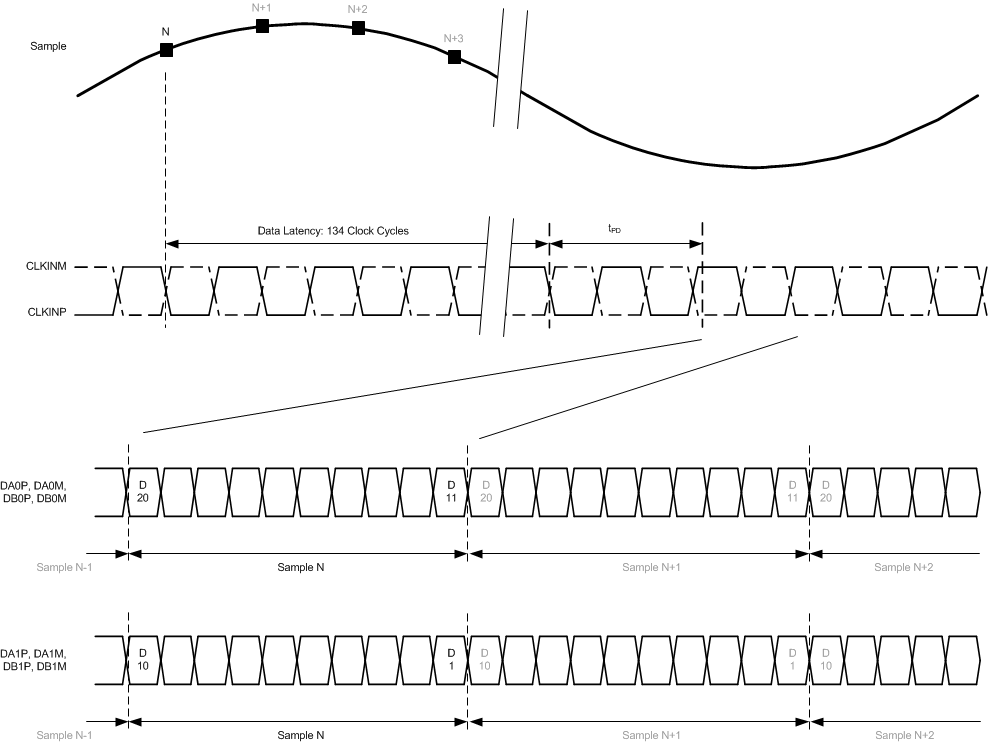 Figure 2. Sample Timing Requirements
Figure 2. Sample Timing Requirements
7.9 Typical Characteristics
typical values are at TA = 25°C, full temperature range is from TMIN = –40°C to TMAX = 85°C, ADC sampling rate = 625 MSPS, 50% clock duty cycle, AVDD3V = 3.0 V, AVDD = DVDD = 1.9 V, IOVDD = 1.15 V, –1-dBFS differential input, and 0-dB digital gain (unless otherwise noted)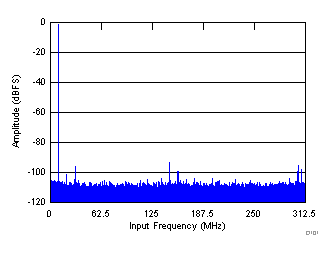
| SNR = 71.9 dBFS, SINAD = 71.86 dBFS, THD = 93 dBc, IL spur = 94 dBc, SFDR = 94 dBc, non HD2, HD3 spur = 94 dBc |
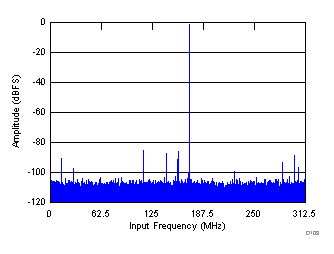
| SNR = 71 dBFS, SINAD = 70.9 dBFS, SFDR = 85 dBc, THD = 84 dBc, IL spur = 87 dBc, non HD2, HD3 spur = 93 dBc |
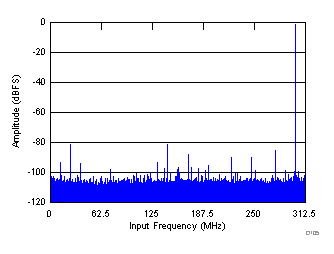
| SNR = 69.5 dBFS, SINAD = 69.1 dBFS, IL spur = 81 dBc, SFDR = 80 dBc, THD = 79 dBc, non HD2, HD3 spur = 90 dBc |


| fIN1 = 185 MHz, fIN2 = 190 MHz, each tone at –36 dBFS, IMD = 107 dBFS |

| fIN1 = 370 MHz, fIN2 = 365 MHz, each tone at –36 dBFS, IMD = 109 dBFS |

| fIN1 = 470 MHz, fIN2 = 465 MHz, each tone at –36 dBFS, IMD = 107 dBFS |
(–36 dBFS)

| fIN1 = 365 MHz, fIN2 = 370 MHz |
(365 MHz and 370 MHz)
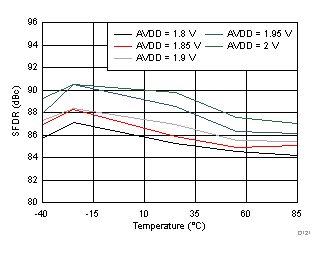
| fIN = 170 MHz |
AVDD Supply and Temperature

| fIN = 350 MHz |
AVDD Supply and Temperature

| fIN = 170 MHz |
DVDD Supply and Temperature

| fIN = 350 MHz |
DVDD Supply and Temperature

| fIN = 170 MHz |
AVDD3V Supply and Temperature

| fIN = 350 MHz |
AVDD3V Supply and Temperature

| fIN = 350 MHz |

| fIN = 350 MHz |

| fIN = 350 MHz |

| fIN = 170 MHz, AIN = –1 dBFS, fPSRR = 5 MHz, APSRR= 50 mVPP, PSRR (AVDD supply) = 51 dB |
for Test Signal on the AVDD Supply

| fIN = 170 MHz, AIN = –1 dBFS, fCMRR = 5 MHz, ACMRR= 50 mVPP, CMRR = 40 dB |

Gain and Input Frequency

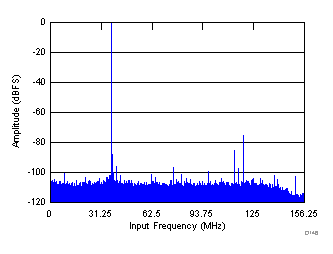
| SNR = 72 dBFS, SINAD = 71.8 dBFS, SFDR = 84 dBc, THD = 83 dBc, non HD2, HD3 spur = 98 dBc |
Decimate-by-2 Mode

| SNR = 77.4 dBFS, SINAD = 77.3 dBFS, SFDR = 105 dBc, THD = 102 dBc, non HD2, HD3 spur = 105 dBc |
Decimate-by-4 Mode

| SNR = 74.9 dBFS, SINAD = 74.8 dBFS, SFDR = 93 dBc, THD = 92 dBc, non HD2, HD3 spur = 93 dBc |
Decimate-by-4 Mode

| SNR = 71.3 dBFS, SINAD = 71.1 dBFS, SFDR = 86 dBc, THD = 85 dBc, IL spur = 87 dBc, non HD2, HD3 spur = 95 dBc |

| SNR = 70.4 dBFS, SINAD = 69.9 dBFS, IL spur = 89 dBc, SFDR = 80 dBc, THD = 79 dBc, non HD2, HD3 spur = 91 dBc |

| SNR = 68.8 dBFS, SINAD = 67.3 dBFS, SFDR = 73 dBc, THD = 72 dBc, IL spur = 81 dBc, non HD2, HD3 spur = 89 dBc |

| fIN1 = 185 MHz, fIN2 = 190 MHz, each tone at –7 dBFS, IMD = 89 dBFS |
||

| fIN1 = 370 MHz, fIN2 = 365 MHz, each tone at –7 dBFS, IMD = 78 dBFS |

| fIN1 = 470 MHz, fIN2 = 465 MHz, each tone at –7 dBFS, IMD = 71 dBFS |

| fIN1 = 185 MHz, fIN2 = 190 MHz | ||
(185 MHz and 190 MHz)
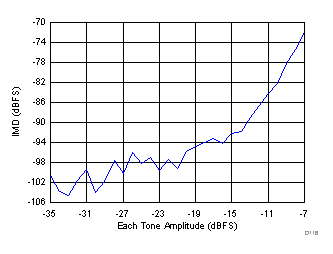
| fIN1 = 465 MHz, fIN2 = 470 MHz |
(465 MHz and 470 MHz)


| fIN = 170 MHz |
AVDD Supply and Temperature

| fIN = 350 MHz |
AVDD Supply and Temperature

| fIN = 170 MHz |
DVDD Supply and Temperature

| fIN = 350 MHz |
DVDD Supply and Temperature

| fIN = 170 MHz |
AVDD3V Supply and Temperature
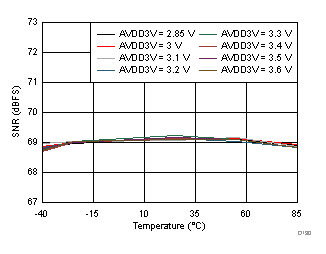
| fIN = 350 MHz |
AVDD3V Supply and Temperature

| fIN = 170 MHz |

| fIN = 170 MHz |
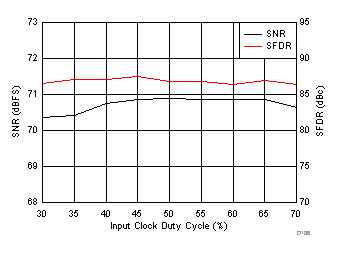
| fIN = 170 MHz |
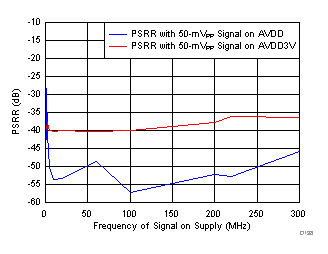
Test Signal on AVDD

Common-Mode Signal

Input Frequency

| NOTE: ADC output amplitude is –1 dBFS, input amplitude is scaled down by the amount of programmed digital gain. |
Gain and Input Frequency

| SNR = 74.1 dBFS, SINAD = 74.09 dBFS, SFDR = 98 dBc, THD = 93 dBc, non HD2, HD3 spur = 99 dBc |
Decimate-by-2 Mode

| SNR = 77.6 dBFS, SINAD = 77.5 dBFS, SFDR = 93 dBc, THD = 92 dBc, non HD2, HD3 spur = 106 dBc |
Decimate-by-4 Mode

| SNR = 76.7 dBFS, SINAD = 76.6 dBFS, SFDR = 96 dBc, THD = 98 dBc, non HD2, HD3 spur = 96 dBc |
Decimate-by-4 Mode
